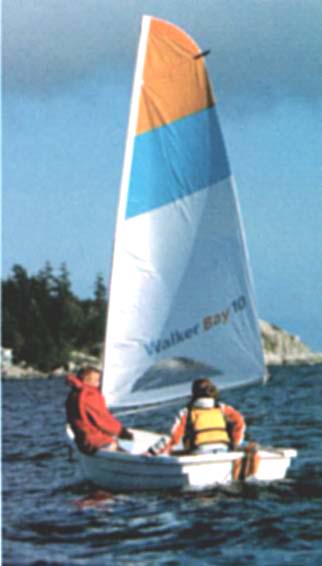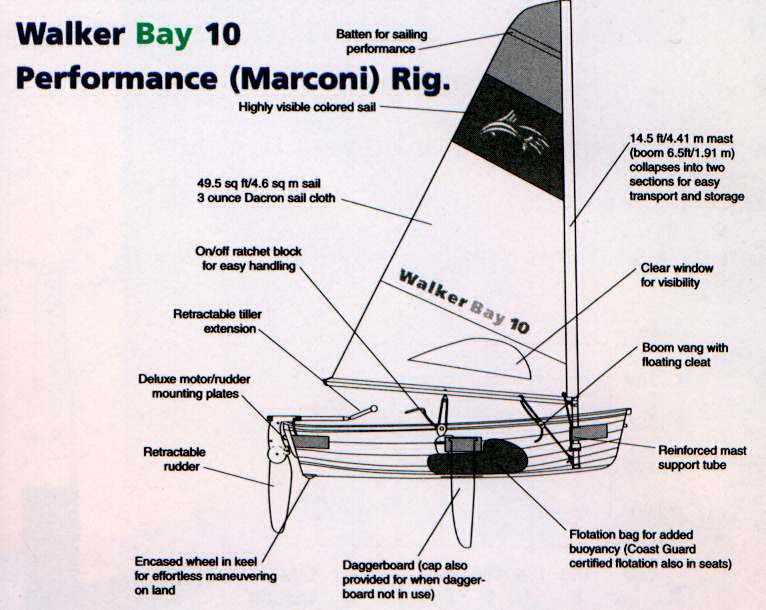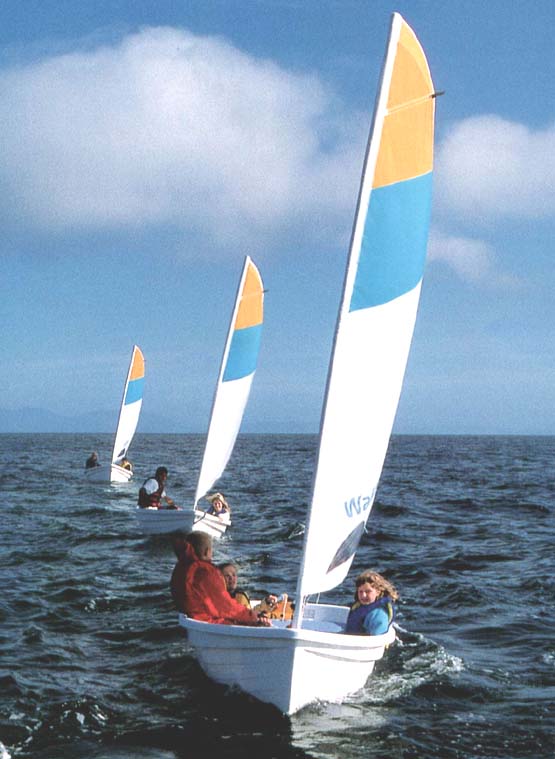
New Boat Review: Walker Bay 10
By Captain Thom Burns
The Walker Bay dinghies are inexpensive. In fact the prices are shocking along the affordability curve. Many people buy Walker Bay boats on a credit card and leave with it on the car.
 |
Walker Bay was kind enough to loan Northern Breezes the sailing version of a
10-footer for a couple of weeks this spring. We rowed and sailed the boat. We
trailered it. We pulled it around on its stern wheel up hills and across parking
lots. The wheel works best on hard surfaces.
The essential fact about these boats is that they're injection molded plastic.
They are a little sterile without even a rail of warm, high maintenance wood.
The Walker Bay 10 is almost no-maintenance and virtually indestructible.
Background
Walker Bay Boats was founded in South Africa in 1997. The company is now based
in Union Gap, Washington, with offices in Vancouver and Paris. The stated aim of
the company is to bring its boats to the masses. They have recorded sales in
fifty countries.
The Walker Bay 8 was first out of the molds in 1998. The 10-footer was
introduced this spring. Both dinghies were designed by Paolo Rista.
Rista has used a good versatile form with ersatz lapstrake construction. This
gives the injection-molded hulls considerable rigidity fore and aft. Strength is
gained in plastic hulls by molded angles, curves and ridges. What could be
better than fake lapstrake boards? The seats support the boats gunwale to
gunwale.
Both boats have a full-length molded keel from the transom to the bow. This adds
stiffness and helps the boats track straight when rowed or towed. It also houses
the rolling wheel aft.
Solid vs. Inflatable
There are good arguments for solid dinghies. They need to be relatively light
and manageable. The eight is the ten is mostly. Solid dinghies do not have
inflation issues. They can be stowed upside-down on the decks of larger boats
and lowered overboard easily. They usually tow better than inflatables. They
always row better, especially in wind.
Construction
Both the 8 and the 10 are made of polypropylene resin, which is injected into a
steel mold and pressed at 10,000 lbs. The boats emerge smooth and detailed. The
basic hull is born in about five minutes.
 |
The solid, foam-filled thwart seats are then set in place and bolted through the
strakes. That's about it for construction.
Performance
Three of us sailed the Walker Bay 10. All are Small Boat Certified sailing
instructors. Mike Bastin, is the former director of Camp St. Croix sailing. In
heavy air, all of us had trouble balancing the boat. If I sat in the back, the
boat sailed down by the stern and dragged. It also had sluggish steering. If I
moved forward, the bow was down slightly. If I moved to the middle and placed
some body weight forward, it would pretty much balance but it was noticeably
uncomfortable. If I kneeled or laid in the boat, it was better balanced, but no
reasonable adult would do that for very long. The boom also sheets in the middle
and to the middle seat which makes it difficult to move around this arrangement.
It would be far better to sheet it from the end of the boom to the stern. This
would open up the cockpit. When you are trying to flatten the boat in high
winds, there is nothing to hook your feet on such as hiking straps. This leaves
you jamming your feet under the seats and hoping you don't slip out of this
position. When tacking, even in light air, the tiller does not go up. You must
slide it back or climb over it. This by now must feel like a litany of problems.
Let me assure you that I'm not a real big guy at 5'9" 170 lbs and reasonably
fit. Many of the problem areas could be easily fixed. The rest are compromises
in a boat designed to do everything: sail, tow and row. If the middle seat were
moved to make it easier to balance and sail the boat, it would no longer be
perfect for rowing. This boat rows very well.
The 10 moved well - hitting 4.5 knots on a reach.
The sailing characteristics we experienced overwhelmed some thoughtful design
work and quality manufacturing on the part of Walker Bay. The sail kit and
fittings are first-rate although it would be nice to be able to cleat off the
main in a jam cleat. The sail with a big window, a tensionable shaping batten
near the head of the sail adds shape and roach. The daggerboard and rudder are
well done as is the rudder mounting system. The blocks and tackle for the main
sheet works well, but we'd prefer to have the sheet simply come down from the
aft end of the boom to the stern which would open up the cockpit. This would be
easy to do even as a retrofit.
 |
The Walker Bay 10 rowed very well. Walker Bay sent along an outstanding pair of
7-1/2' wooden oars with rubber collars. They set neatly in plastic oarlocks. The
oarlocks fit fore and aft in the gunwale sockets, as they are turned outboard
they lock.
Conclusions
The Walker Bay 10 is a well built, nicely designed dinghy. It carries quite a
bit and it rows well. It is much less impressive as a sailboat. I would make a
few changes to make it a much friendlier and comfortable sailing dinghy. I would
trim the main from the end of the boom which would open up the cockpit. I would
add a foot to the mast and raise the boom a foot to also clear the cockpit of
obstacles - the boom. I would place some hiking straps in the boat for high
winds. I would make the tiller go up and down for easier movement. This boat
does several things that it is supposed to do very well: row, tow, carry. It
could be more fun as a sailing dinghy with a few changes. It is a great value in
boating if you play to its strong suite.
Captain Thom Burns publishes Northern Breezes and Sailing Breezes.